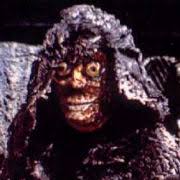
The story begins with a Star-Wars crawl as Tom Baker narrates the story of Gallifrey. The Doctor has a vision about the President of the Time-Lords being assassinated. He goes to Gallifrey to stop it. In the Panopticon—the Gallifreyan ceremonial chamber—he sees a sniper on a catwalk. He fights his way up to the catwalk, shouting out a warning. But the assassin is down among the delegates and kills the President. Everybody sees the Doctor on the catwalk with the gun and assumes he is the killer. It appears the Doctor cannot even go home without being accused of murder. When the Doctor maintains his innocence under interrogation, Castellan Spandrell (George Pravda) starts to believe him and orders co-ordinator Engin (Erik Chitty) to help investigate. The Doctor invokes Article 17 by running for President, which gives him liberty in the meantime.
It seems the Master sent the premonition that started all this through the Matrix and the Doctor decides to enter the Matrix to track down the Master. Yes, Doctor Who invented the Matrix 23 years before the Keanu Reeves movie. In the Matrix, which seems awfully like Earth despite the psychedelic trappings, he confronts an assassin who turns out to be Chancellor Goth (Bernard Horsfall). The Master tries to trap the Doctor there. He is saved but Goth is burnt to death.
The Doctor and Spandrell, with soldiers at their side, enter the chamber where the Master and Goth had access to the Matrix. The Master has no pulse and Goth is dying. The latter says he found the Master on Terserus, at the end of his final regeneration. He helped the Master to gain power. Before dying. He warns that the Master has a doomsday plan. The President of Gallifrey has access to the Sash and the Great Key of Rassilon. Rassilon obtained the Eye of Harmony within the “black void”. The Doctor realizes that these are more than ceremonial objects and that the Master is only injected with a neural inhibitor and is still alive. In the Morgue, the Master (Peter Pratt literally looking like death warmed over) is still alive. He seizes the sash from the President’s corpse and traps the Doctor and his other enemies. The Eye of Rassilon, it seems, is the nucleus of a black hole which powers Gallifrey, and the sash and key are control devices. The Master can use this for a new cycle of regenerations, but Gallifrey and a hundred other worlds will be consumed.
Inside the Panopticon, the Master makes his way to the Obelisk where the Eye is located. He is prepared to access the energy. The Citadel quakes, and cracks appear as the Doctor crawls his way to the Obelisk through the service shaft. The Doctor and the Master fight, and the Master falls into a chasm. The Doctor reconnects the power, and though half the city is in ruins and many have died, Gallifrey is saved. Returning to his rickety old Type 40 TARDIS, the Doctor warns that the Master collected a great deal of energy and may still be alive. Indeed, Spandrell and Elgin see the Master’s TARDIS dematerializing a moment later.
Tom Baker wanted to try a story without a companion and writer Robert Holmes discovered that was very difficult to do. This serial, however, pretty much created Gallifrey, the lore of the Time-Lords, and their gorgeous trappings. The Pyrdonians wear scarlet and orange, the Arcalians wear green, and the Patrexes heliotrope. A slang term for regeneration is face-lift. There is mention of a secretive organization called the Celestial Intervention Agency, or the CIA. The fact that Time-Lords can have only 13 lives was canon law in Doctor Who until it needed to be changed in later stories. In the Matrix, there is a 1949 Stampe SV.4C Biplane, which was used in Indiana Jones and the Last Crusade and The Mummy. The cliff-hanger in which the Doctor is drowned raised the ire of those dedicated to protecting the tender psyches of children, possibly because Tom Baker had a fear of drowning and was genuinely terrified.
Part 1
Part 2
Part 3
Part 4
